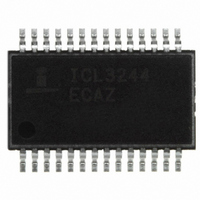ICL3244ECAZ-T Intersil, ICL3244ECAZ-T Datasheet - Page 10

ICL3244ECAZ-T
Manufacturer Part Number
ICL3244ECAZ-T
Description
TRANSMITTER/RCVR RS232 28-SSOP
Manufacturer
Intersil
Type
Transceiverr
Datasheet
1.ICL3244ECAZ-T.pdf
(20 pages)
Specifications of ICL3244ECAZ-T
Number Of Drivers/receivers
3/5
Protocol
RS232
Voltage - Supply
3 V ~ 5.5 V
Mounting Type
Surface Mount
Package / Case
28-SSOP
Peak Reflow Compatible (260 C)
Yes
Rohs Compliant
Yes
Lead Free Status / RoHS Status
Lead free / RoHS Compliant
Other names
ICL3244ECAZ-TTR
Available stocks
Company
Part Number
Manufacturer
Quantity
Price
Company:
Part Number:
ICL3244ECAZ-T
Manufacturer:
INTERSIL
Quantity:
10 071
Powerdown Functionality
This 3V family of RS-232 interface devices requires a
nominal supply current of 0.3mA during normal operation
(not in powerdown mode). This is considerably less than the
5mA to 11mA current required of 5V RS-232 devices. The
already low current requirement drops significantly when the
device enters powerdown mode. In powerdown, supply
current drops to 1µA, because the on-chip charge pump
turns off (V+ collapses to V
the transmitter outputs three-state. Inverting receiver outputs
may or may not disable in powerdown; refer to Table 2 for
details. This micro-power mode makes these devices ideal
for battery powered and portable applications.
Software Controlled (Manual) Powerdown
These devices allow the user to force the IC into the low
power, standby state, and utilize a two pin approach where
the FORCEON and FORCEOFF inputs determine the IC’s
mode. For always enabled operation, FORCEON and
FORCEOFF are both strapped high. To switch between
FIGURE 3. DISABLED RECEIVERS PREVENT POWER DRAIN
POWERED
FIGURE 2. POWER DRAIN THROUGH POWERED DOWN
DOWN
UART
POWERED
DOWN
V
UART
WAKE-UP
GND
CC
LOGIC
V
TO
CC
R
T
PERIPHERAL
X
X
FORCEOFF = GND
TRANSITION
DETECTOR
Rx
Tx
V
CC
V
SHDN = GND
OUT
R2
V
OUTB
R2
OUT
= HI-Z
V
CC
T1
CC
OUT
10
= V
IN
, V- collapses to GND), and
CC
ICL3244E
RS-232 CHIP
OLD
V
CURRENT
FLOW
ICL3224E, ICL3226E, ICL3244E
CC
R2
T1
OUT
IN
active and powerdown modes, under logic or software
control, only the FORCEOFF input need be driven. The
FORCEON state isn’t critical, as FORCEOFF dominates
over FORCEON. Nevertheless, if strictly manual control over
powerdown is desired, the user must strap FORCEON high
to disable the enhanced automatic powerdown circuitry.
ICL3244E inverting (standard) receiver outputs also disable
when the device is in powerdown, thereby eliminating the
possible current path through a shutdown peripheral’s input
protection diode (see Figures 2 and 3).
Connecting FORCEOFF and FORCEON together disables
the enhanced automatic powerdown feature, enabling them
to function as a manual SHUTDOWN input (see Figure 4).
With any of the above control schemes, the time required to
exit powerdown, and resume transmission is only 100µs.
When using both manual and enhanced automatic
powerdown (FORCEON = 0), the ICL32XXE won’t power up
from manual powerdown until both FORCEOFF and
FORCEON are driven high, or until a transition occurs on a
receiver or transmitter input. Figure 5 illustrates a circuit for
ensuring that the ICL32XXE powers up as soon as
FORCEOFF switches high. The rising edge of the Master
Powerdown signal forces the device to power up, and the
ICL32XXE returns to enhanced automatic powerdown mode
an RC time constant after this rising edge. The time constant
isn’t critical, because the ICL32XXE remains powered up for
30 seconds after the FORCEON falling edge, even if there
are no signal transitions. This gives slow-to-wake systems
(e.g., a mouse) plenty of time to start transmitting, and as
long as it starts transmitting within 30 seconds both systems
remain enabled.
FIGURE 4. CONNECTIONS FOR MANUAL POWERDOWN
CPU
LOGIC
PWR
MGT
WHEN NO VALID RECEIVER SIGNALS ARE
PRESENT
UART
I/O
FORCEOFF
FORCEON
INVALID
ICL32XXE













